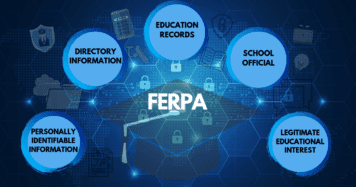In this series, Privacy and Pandemics, the Future of Privacy Forum explores the challenges posed by the COVID-19 crisis to existing ethical, privacy, and data protection frameworks, and will seek to provide information and guidance to companies and researchers interested in responsible data sharing to support public health response. Previous posts include an FAQ on COVID-19 FERPA disclosures, guidance on the privacy concerns around using social media for online learning, the use of location data, and our list of COVID-19: Privacy & Data Protection Resources.
As school buildings around the country close in order to protect the health of students, families, staff, and their larger communities, many schools are rapidly shifting instruction to online platforms. During this transition, it’s critical to take steps to protect students’ data. Today, the Future of Privacy Forum (FPF) released the following best practices, also available as a printable PDF here, to help schools and educators maintain appropriate student privacy measures during the COVID-19 pandemic:
 Be wary of using technology not intended for educational settings. In the rapid shift to distance learning, educators may adopt technologies without fully ensuring that the tools—such as general-audience applications on social media, gaming, or webinar platforms—have appropriate student privacy protections. Because these products are not designed for educational settings, there is a heightened risk these tools could collect and commercialize students’ information. They could also inappropriately blur the lines between students’ personal and academic lives when students are asked to use personal accounts for online learning. Districts should share lists of approved tools through an easily accessible, public-facing website so that educators, parents, students, and other stakeholders are informed and can ensure accountability.
Be wary of using technology not intended for educational settings. In the rapid shift to distance learning, educators may adopt technologies without fully ensuring that the tools—such as general-audience applications on social media, gaming, or webinar platforms—have appropriate student privacy protections. Because these products are not designed for educational settings, there is a heightened risk these tools could collect and commercialize students’ information. They could also inappropriately blur the lines between students’ personal and academic lives when students are asked to use personal accounts for online learning. Districts should share lists of approved tools through an easily accessible, public-facing website so that educators, parents, students, and other stakeholders are informed and can ensure accountability.
 Remain mindful of state and federal laws that protect students’ data privacy. Federal student privacy laws such as the Family Educational Rights and Privacy Act (FERPA), the Children’s Online Privacy Protection Act (COPPA), and state laws protecting students’ information still apply to online and distance learning. Tools designed for non-educational settings might not comply with these laws. If a service’s privacy promises do not specifically reference COPPA, FERPA, or students, that is a sign that they may not be targeted to schools, and therefore may not be in compliance with student or child privacy laws.
Remain mindful of state and federal laws that protect students’ data privacy. Federal student privacy laws such as the Family Educational Rights and Privacy Act (FERPA), the Children’s Online Privacy Protection Act (COPPA), and state laws protecting students’ information still apply to online and distance learning. Tools designed for non-educational settings might not comply with these laws. If a service’s privacy promises do not specifically reference COPPA, FERPA, or students, that is a sign that they may not be targeted to schools, and therefore may not be in compliance with student or child privacy laws.
 Practice transparency. Ensure that students and parents know what data is being collected, how it will be used, and how it will be protected. Without full transparency, students and parents could feel blindsided when schools and educators act on the information collected by educators or online learning tools, and students may seek ways to circumvent the tools if they don’t trust that the school will use the information to best serve students. For example, educators who record class sessions should first notify students and parents to explain why the recording is necessary and how long it will be stored. If a tool tracks when students click away from their screens, educators should inform students and parents and explain how this information may be used to evaluate engagement.
Practice transparency. Ensure that students and parents know what data is being collected, how it will be used, and how it will be protected. Without full transparency, students and parents could feel blindsided when schools and educators act on the information collected by educators or online learning tools, and students may seek ways to circumvent the tools if they don’t trust that the school will use the information to best serve students. For example, educators who record class sessions should first notify students and parents to explain why the recording is necessary and how long it will be stored. If a tool tracks when students click away from their screens, educators should inform students and parents and explain how this information may be used to evaluate engagement.
 Minimize the data collected about or from students. Schools should prioritize tools that do not require students to create individual accounts in an effort to minimize the amount of student data collected. Encourage students to enter only the information necessary to use a tool. Administrators and educators should check the tools’ default settings and adjust any that could pose unnecessary privacy risks, such as automatically launching students’ webcams when a class starts. Schools should also take advantage of this opportunity to build students’ digital citizenship skills by encouraging them to use browser plugins to block ads and online trackers, to create strong passwords, and by teaching them how to change their own privacy settings.
Minimize the data collected about or from students. Schools should prioritize tools that do not require students to create individual accounts in an effort to minimize the amount of student data collected. Encourage students to enter only the information necessary to use a tool. Administrators and educators should check the tools’ default settings and adjust any that could pose unnecessary privacy risks, such as automatically launching students’ webcams when a class starts. Schools should also take advantage of this opportunity to build students’ digital citizenship skills by encouraging them to use browser plugins to block ads and online trackers, to create strong passwords, and by teaching them how to change their own privacy settings.
 Be mindful of accessibility challenges. Schools should ensure that new online learning tools do not pose additional barriers for vulnerable students who must now learn from home. For example, lessons delivered via video conferencing platforms without captions disadvantage English-language learners or hearing-impaired students. Tools requiring high bandwidth create accessibility issues for students without reliable home internet connections, and, unless the school is providing a device, students may be accessing assignments through a mobile or shared family device. Consider using tools and formats that students can download and watch later, that require less data usage, and that users with disabilities can access. Be prepared to offer alternatives if students cannot use an online tool, and regularly request student feedback to learn what works best.
Be mindful of accessibility challenges. Schools should ensure that new online learning tools do not pose additional barriers for vulnerable students who must now learn from home. For example, lessons delivered via video conferencing platforms without captions disadvantage English-language learners or hearing-impaired students. Tools requiring high bandwidth create accessibility issues for students without reliable home internet connections, and, unless the school is providing a device, students may be accessing assignments through a mobile or shared family device. Consider using tools and formats that students can download and watch later, that require less data usage, and that users with disabilities can access. Be prepared to offer alternatives if students cannot use an online tool, and regularly request student feedback to learn what works best.
 Remember professional development. Like students, educators also need additional resources and tools to excel during this challenging time. The move to online learning will be a new experience for most educators, and it is worth the time investment for state and local education agencies to provide relevant professional development opportunities. Students benefit most from educators who know how to find and use resources that provide a great learning experience and are privacy-protective. While privacy may not seem like the #1 priority during a crisis of this magnitude, maintaining a foundation of trust between schools and parents is crucial to supporting students and providing a quality education.
Remember professional development. Like students, educators also need additional resources and tools to excel during this challenging time. The move to online learning will be a new experience for most educators, and it is worth the time investment for state and local education agencies to provide relevant professional development opportunities. Students benefit most from educators who know how to find and use resources that provide a great learning experience and are privacy-protective. While privacy may not seem like the #1 priority during a crisis of this magnitude, maintaining a foundation of trust between schools and parents is crucial to supporting students and providing a quality education.
 Remember that this is not normal. These circumstances are extraordinarily stressful for many families, and the data collected during this time will not reflect what students can typically achieve. Therefore, during this crisis, collecting certain evaluative data about students, such as attentiveness or behavior during a class session, may not be worth the privacy tradeoffs. Take time to ensure evaluations are fair and the data collected informs rather than controls the narrative. Although many state education reporting requirements are still in effect, reporting during this time can still reflect awareness of current circumstances and protect privacy.
Remember that this is not normal. These circumstances are extraordinarily stressful for many families, and the data collected during this time will not reflect what students can typically achieve. Therefore, during this crisis, collecting certain evaluative data about students, such as attentiveness or behavior during a class session, may not be worth the privacy tradeoffs. Take time to ensure evaluations are fair and the data collected informs rather than controls the narrative. Although many state education reporting requirements are still in effect, reporting during this time can still reflect awareness of current circumstances and protect privacy.
For more resources and information on ensuring students’ privacy during the transition to online learning programs, visit FPF’s resource page on student privacy during the COVID-19 pandemic.
Amelia Vance is FPF’s Director of Youth & Education Privacy and Anisha Reddy is a Policy Fellow at FPF. Alexis Shore is a graduate student of emerging media studies at Boston University with research focusing on privacy and government surveillance.




